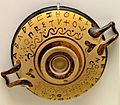Greek alphabet facts for kids
Quick facts for kids Greek alphabet |
|
|---|---|
| Type | Alphabet |
| Spoken languages | Greek |
| Time period | c. 800 BC – present |
| Parent systems |
Egyptian hieroglyphs
|
| Child systems |
|
| Unicode range |
|
| ISO 15924 | Grek |
| Note: This page may contain IPA phonetic symbols in Unicode. | |
The modern Greek alphabet has 24 letters. It is used to write the Greek language. The Greek alphabet is also frequently used in science and mathematics to represent various entities. Most letters in the Greek alphabet have equivalent in the English language.
The Greek alphabet is thought to be where all important European alphabets came from. The alphabet was borrowed from the Phoenician alphabet around the 10th century BC, with many changes to make it fit the Greek language. The main change was that some of the Phoenician letters that were for sounds not used in Greek were turned into vowels. The Phoenicians had written their alphabet without any vowels, so this change made reading easier. This change was also better fit for Indo-European languages, which did not use consonant-based roots (meaning the word's central meaning is based on the consonant string) like those in Semitic languages such as Phoenician, Arabic, Hebrew, and Aramaic. Another change is that some new letters were invented for sounds that were in Greek but not in the Phoenician language. At first, Greek was written from right to left, same as Phoenician, but after the 6th century BC, it was written from left to right.
There were some differences in the early Greek alphabet depending on what part of the Greek world it was used in. The two main kinds were the eastern and western ones. But over time, all Greeks started to use the same alphabet, especially after the Ionic alphabet of Miletus was officially adopted in Athens in 403 BC. A little later, the rest of Greece did the same, and by 350 BC, during the life of Alexander the Great, almost all Greeks were using the same twenty-four letter Greek alphabet.
Later, Aristophanes of Byzantium (c. 257–185 BC), a Greek scholar and grammarian, invented the three diacritics (accent marks): acute, grave, and circumflex, to mark the tone or pitch of Greek words.
Although the Greek letters accurately represented all the main sounds of the Greek language early on, the sounds of the Greek language changed over time. Some of the vowel sounds began to sound similar to one another, aspirated voiceless stops became voiceless fricatives, and voiced stops became voiced fricatives. One can get an idea of how older Greek pronunciations sounded like, by looking at the Latin and English spellings of Greek loanwords like "philosopher", "Chimera", "Cyprus", and "Thessalonica" .
Rough breathing or "H" sound
Another diacritic is a comma, usually above initial vowels. This signaled whether or not the sound of the letter 'H' was present. It is not available in our standard character-set. If this comma-like diacritic above the vowel is reversed, it indicates the presence of an /h/ sound before a vowel, diphthong, or rho. Thus, the Greek name Ἕκτωρ is pronounced Hektōr, not Ektor. Another example is ἥρως, pronounced hḗrōs ("hero").
Modern orthography
In 1982, a new, simplified orthography, known as "monotonic", was adopted for official use in Modern Greek by the Greek state. It uses only a single accent mark, the acute accent. This marks the stressed syllable of polysyllabic words, that is, words with more than one syllable.
Related pages
Images for kids
-
A 16th-century edition of the New Testament (Gospel of John), printed in a renaissance typeface by Claude Garamond
See also
 In Spanish: Alfabeto griego para niños
In Spanish: Alfabeto griego para niños






